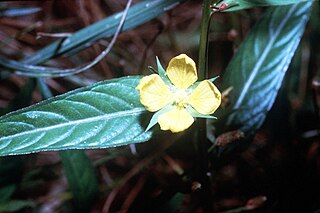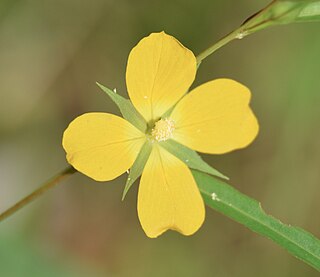
Pachypodium brevicaule is a species of plant that belongs to the family Apocynaceae.

Ludwigia is a genus of about 82 species of aquatic plants with a cosmopolitan but mainly tropical distribution.

Ludwigia alternifolia, commonly known as seedbox, bushy seedbox, rattlebox, and square-pod water-primrose, is a herbaceous perennial plant of the family Onagraceae. It is native to central and eastern North America, growing in marshes, wet meadows, and swamps. It has yellow, four-petaled flowers and brown seed pods that are shaped like a cube.

Ludwigia sedioides, commonly known as mosaic flower and false loosestrife, is a herbaceous perennial plant of the family Onagraceae. It has yellow flowers that bloom from June to August. Native to Brazil and Venezuela, its habitat includes wet, swampy localities.

Eurybia divaricata, the white wood aster, is an herbaceous plant native to eastern North America. It occurs in the eastern United States, primarily in the Appalachian Mountains, though it is also present in southeastern Canada, in the provinces of Ontario, Quebec and Nova Scotia. In the U.S. it is abundant and common, but in Canada it is considered threatened due to its restricted distribution. It has been introduced to a number of countries in Europe. It can be found in dry open woods as well as along wood-edges and clearings. The species is distinguished by its flower heads that have yellow centers and white rays that are arranged in flat-topped corymbiform arrays, emerging in the late summer through fall. Other distinguishing characteristics include its serpentine stems and sharply serrated narrow heart-shaped leaves. The white wood aster is sometimes used in cultivation in both North America and Europe due to it being quite tough and for its showy flowers.

Lobelia siphilitica, the great blue lobelia, great lobelia, or blue cardinal flower, is a plant species within the family Campanulaceae. It is an herbaceous perennial dicot native to eastern and central Canada and United States. There are two recognized varieties of Lobelia siphilitica, var. siphilitica and var. ludoviciana. Blooming from August to October, it is short-lived, lasting only for a few years.

Camissoniopsis bistorta is a species of flowering plant in the evening primrose family known by the common names southern suncup and California suncup. It is native to southern California and Baja California, where it grows in several types of plant community along the coast and in the coastal hills and mountain ranges. This is a hairy annual or short-lived perennial herb spreading from a basal rosette, with stems reaching up to 80 centimeters long. The leaves are narrow and sometimes toothed, and 1 to 12 centimeters in length. Toward the end of the spreading stems are nodding inflorescences of flowers, each flower with four bright yellow petals dotted with red at their bases.

Spathoglottis plicata, commonly known as the Philippine ground orchid, or large purple orchid is an evergreen, terrestrial plant with crowded pseudobulbs, three or four large, pleated leaves and up to forty resupinate, pink to purple flowers. It is found from tropical and subtropical Asia to Australia and the western Pacific including Tonga and Samoa.

Ludwigia peploides is a species of flowering plant in the evening primrose family known by the common names floating primrose-willow and creeping water primrose. It is native to Australia, North America, and South America, but it can be found on many continents and spreads easily to become naturalized. It is well known as a troublesome aquatic noxious weed that invades water ecosystems and can clog waterways. This is perennial herb which grows in moist to wet to flooded areas. The stem can creep over 2 meters long, sometimes branching. It spreads to form mats on the mud, or floats ascending in the water. The leaves are several centimeters long and are borne in alternately arranged clusters along the stem. The flower has 5 to 6 lance-shaped sepals beneath a corolla of 5 or 6 bright yellow petals up to 2.4 centimeters long. The fruit is a hard, cylindrical capsule.

Portulaca pilosa is a species of flowering succulent plant in the purslane family, Portulacaceae, that is native to the Americas. Its common names include pink purslane, kiss-me-quick and hairy pigweed. Its range extends from the southern United States and the Caribbean as far as Brazil. It is a succulent plant with linear leaves and pink flowers.

Cardiospermum halicacabum, known as the lesser balloon vine, balloon plant or love in a puff, is a climbing plant widely distributed across tropical and subtropical areas of Africa, Australia, and North America that is often found as a weed along roads and rivers.

Oenothera macrocarpa, the bigfruit evening primrose, Ozark sundrops, Missouri evening primrose, or Missouri primrose, is a species of flowering plant in the evening primrose family Onagraceae, native to northeast Mexico and the south-central United States, where it is found in calcareous prairies and limestone outcrops.

Ludwigia decurrens is a species of flowering plant in the evening primrose family known by the common names willow primrose and wingleaf primrose-willow. It is native to the central and eastern United States.

Ludwigia octovalvis is a species of flowering plant in the Onagraceae family known by the common name Mexican primrose-willow. Its native distribution is unclear, but can be found in Central America, Australia, South-East Asia, Tamilnadu (IND), the Middle East, the Central-West African regions and spreads easily to become naturalized. It is also cultivated as an aquatic plant. The plant is known for its anti-aging properties. The species is sometimes regarded as an invasive species and is classified by IUCN as of "least concern" with stable populations. An adult plant is one meter tall on average but is able to grow taller. It spreads to form mats on the mud, rooting at nodes in contact with the substrate, or floats ascending in the water. Its flowers are yellow in appearance. They are made up of green and red stems. They yield small capsular fruits containing many minute seeds.

Ludwigia peruviana, with the common names Peruvian primrose-willow or Peruvian water primrose, is an aquatic, sometimes deciduous species of flowering plant in the evening primrose family. It can grow to approximately 12 feet (3.7 m) in height. While native to Peru, it has been introduced in many other countries for its attractive simple yellow flowers, it is now a common weed in swampy areas around the world.

Zieria pilosa, commonly known as hairy zieria, is a plant in the citrus family Rutaceae and is endemic to coastal New South Wales. It is a shrub with hairy branches, leaves composed of three leaflets and usually only single white to pale pink flowers in the leaf axils.

Boronia pilosa, commonly known as the hairy boronia, is a plant in the citrus family Rutaceae and is endemic to south-eastern Australia. It is an erect, woody shrub with hairy branches, pinnate, sometimes hairy leaves and groups of up to ten white to pink, four petalled flowers.

Ludwigia grandiflora, the water primrose, is an aquatic plant of the order Myrtales.
Plectranthus purpuratus or cliff spurflower is a species of flowering plant in the family Lamiaceae, native to South Africa's Kwazulu-Natal and Mpumalanga provinces, as well as eSwatini. The name is frequently misapplied to Plectranthus ciliatus, presumably because both have purple-backed leaves.
Epacris pilosa is a species of flowering plant in the heath family Ericaceae and is endemic to eastern New South Wales. It is low-lying shrub with weeping, shaggy-hairy branchlets, elliptic to more or less egg-shaped leaves and white or cream-coloured tube-shaped flowers.

















